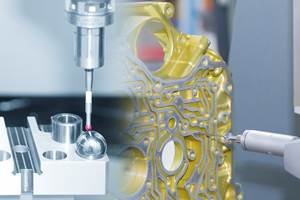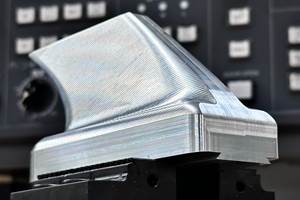How to Correctly Measure Surface Finish
When providing surface finish specs, engineers sometimes leave out the actual testing parameters. Here’s how to be sure measurements are as accurate as possible.
Share






When an engineer includes a surface finish spec on a print, the intent is usually not just to make the part look good. Surface finish affects how a part will fit, wear, reflect light, transmit heat, distribute lubrication and accept coatings. The finish should be determined by the part's function; ideally, the surface should fulfill the engineering requirements of the application without wasting time and effort on producing a higher quality finish than is necessary. In fact, many applications do better with a certain amount of “texture.” Too fine a finish can be as bad as too coarse.
Surface finish — also known as profile — includes two components: waviness and roughness. Waviness, or longer-wavelength variation, is caused by macro-type influences, such as worn spindle bearings or vibration from other equipment on the shop floor. Roughness is the short-wavelength pattern of tool marks from grinding, milling or other machining processes, and is affected by the condition and quality of the tooling. Both can be influenced by the operator's choice of feed rate and depth of cut.
Most surface finish checks are done on machined surfaces where a cutting tool has been run across a surface and the resulting tool marks create the profile. But there are other ways of creating a surface finish and it can be just as important to ensure that those resultant surfaces also meet their engineers’ design requirements. For example, surfaces can be created by grinding, polishing or grit-blasting, which may have requirements for specific peaks and valleys so the surface can be coated with specialized materials.
One problem that often occurs is that, while the engineer includes the surface finish spec on the print, the actual testing parameters are not included. Normally, Ra is used to measure the roughness of a surface; however, with any surface finish measuring device, there are numerous parameters that should be set to ensure the correct roughness measurement result.
Today, standards for surface finishing provide recommendations for what the surface finish result should be in addition to the appropriate measurement parameters, such as cutoff length. If these parameters are not specified, there is a strong likelihood of incorrect results from surface finish measurements.
Different types of surface manufacturing techniques are used to produce very different types of surfaces. The machining process, with its cutting tools, spindles and slides, tends to produce a “periodic” surface — one that shows a clear repeating profile; the tool marks are easily distinguished. On the other hand, grinding or grit-blasting produces a non-periodic surface — in other words, it does not have a repeating profile. Incorrect measurement setup can produce errors in either technique.
When measuring surface roughness, the first step is to filter out the waviness component from the roughness component. This is done by breaking the total measuring length of the surface finish measuring stroke into small segments, called cutoff length. Typically, the default cutoff length is set at 0.8 mm. When using this cutoff length on these types of surfaces, there is a chance that an incorrect roughness reading may result. Therefore, if no specified parameter setting for cutoff is called out on the part print, the surface standards define a procedure for selecting the correct cutoff for the surface.
Periodic surfaces are characterized by equally spaced, recurring, typical profile characteristics that are clearly visible in both the depiction of the test surface as well as in the profile. Images courtesy of George Schuetz.
A table helps determine the proper cutoff according to the profile type, either periodic or non-periodic. It requires a bit of experimentation, but it is worth the effort to achieve the proper test results.
Once the type of surface is determined (periodic or non-periodic), columns in the table guide to the proper cutoff setting. If the surface is periodic, the Rsm mean width of the roughness profile elements is used to indicate the correct cutoff length. First, determine the profile length and the chart will recommend a cutoff length. If another measurement produces a result where the Rsm and cutoff length agree, then the Ra is apt to be correct.
On the other hand, if the surface is non-periodic, the table makes a cutoff length recommendation based on the measured Ra. A number of measurements are then made to find the best match of Ra and cutoff length. This is a bit of a tedious process but one that goes a long way to ensure the best surface roughness result.
Non-periodic profiles do not show any visually striking special surface or a distinct working direction on the surface.
Of course, it’s a lot easier when the engineer includes all the setup parameters on the surface callout, but if not, there is a way to ensure the best potential setup and results in the surface standards.
Related Content
Rethink Quality Control to Increase Productivity, Decrease Scrap
Verifying parts is essential to documenting quality, and there are a few best practices that can make the quality control process more efficient.
Read MoreCustom Workholding Principles to Live By
Workholding solutions can take on infinite forms and all would be correct to some degree. Follow these tips to help optimize custom workholding solutions.
Read More6 Machine Shop Essentials to Stay Competitive
If you want to streamline production and be competitive in the industry, you will need far more than a standard three-axis CNC mill or two-axis CNC lathe and a few measuring tools.
Read MoreHow to Mitigate Risk in Your Manufacturing Process or Design
Use a Failure Mode and Effect Analysis (FMEA) form as a proactive way to evaluate a manufacturing process or design.
Read MoreRead Next
AMRs Are Moving Into Manufacturing: 4 Considerations for Implementation
AMRs can provide a flexible, easy-to-use automation platform so long as manufacturers choose a suitable task and prepare their facilities.
Read MoreLast Chance! 2025 Top Shops Benchmarking Survey Still Open Through April 30
Don’t miss out! 91ÊÓƵÍøÕ¾ÎÛ's Top Shops Benchmarking Survey is still open — but not for long. This is your last chance to a receive free, customized benchmarking report that includes actionable feedback across several shopfloor and business metrics.
Read MoreMachine Shop MBA
Making Chips and 91ÊÓƵÍøÕ¾ÎÛ are teaming up for a new podcast series called Machine Shop MBA—designed to help manufacturers measure their success against the industry’s best. Through the lens of the Top Shops benchmarking program, the series explores the KPIs that set high-performing shops apart, from machine utilization and first-pass yield to employee engagement and revenue per employee.
Read More





















